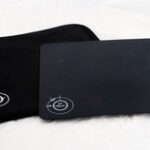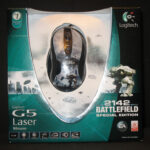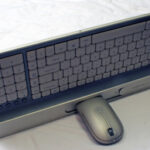Microsoft Paint is a very basic art program that comes default with any version of Microsoft Windows. It’s simple to use, and many people know the basics of the program. What many people don’t know, however, is that this basic art program is capable of producing incredible works of art. You don’t need a $600 professional art program to create top quality digital drawings – all you need is a few tips and tricks up your sleeve, and a free copy of MS Paint.
As a side note, I use a mouse, and my instructions are reflective of that. Using a tablet might be different, and it probably a whole lot easier. If you have a tablet, good for you! I hope you can learn something anyway. And for those of us who are stuck with a good old mouse… well, this only proves that nothing is impossible with a little (okay, a lot) of practice.
To begin, open a new file in MS Paint and resize the drawing space to your liking. Pick any color other than black (I wouldn’t recommend white, either, if you want to see what you’re doing) – let’s just pretend you’re using blue for the purpose of this tutorial. Make a rough sketch of your drawing with the pencil or brush tool (whichever you’re more comfortable with). Don’t worry about how messy it is. When you’re done laying down some basic guidelines, I recommend picking another color (like red) and going over your sketch to edit things and flesh out the lines until you are satisfied with the way it looks.
You’re ready to draw the lines! For inking your line art, select the color black and the curve tool. This tool takes a little while to get used to, but once you do it’s very easy to perfect. To se it, hold down the left mouse button and drag from one end of a line to the other. This creates a straight line between the two points. Shape the line by clicking next to it and moving it around until it looks good to you. You do this twice, once with the first half of the line and then with the other (as determined by the direction you stroked it in) so remember where you start your line!
When you create a line art, it’s a good idea to vary the thickness of the lines. Think of shadows and highlights and the way in which light hits certain things. This gives depth to your drawing before you even color it.
Another thing to keep in mind: undo and save are your friends. I always keep my fingers hovering over the keyboard shortcut for undo (Ctrl+z). Keep in mind that Paint only allows you to undo three times in a row. This is why you should save a lot (Ctrl+s). Make sure you save as a .png or a .bmp file, NOT a .jpg file, or you won’t be able to clean up your drawing later. Redo (Ctrl+y) is also a good shortcut to know, just in case.
When you finish creating your line art, you should be left with crisp black lines, with blue (and whatever other color you used) scribbles in the background, from your sketch. Select the eraser tool and pick the largest available size. On the bottom of the screen, to the left of your default color palette, are two overlapping boxes. Right now they should both be white. Use the dropper tool to select the blue you were using (or simply select it in your color palette). This should turn the top box blue, while the bottom one remains white. Now, using the right mouse button, go over your sketch lines. Don’t worry about your black lines – the eraser will only get rid of the blue. Do the same for any other color you used in your sketch, and you’ll be left with a clean black line art and no trace of the original sketch. Don’t forget to change the eraser foreground color back to white.
On to the coloring! At this point, I like to save a separate copy of the file so that I have a copy of the uncolored lines. I prefer to lay down all my basic colors before I start shading. To do this, use the fill tool (the bucket). In areas that are not fully enclosed, use the color you plan to fill with to block up the gaps. Get a variety of more interesting colors to choose from by going to “Colors – Edit colors…” It’s also a good idea to zoom in (the magnifying glass tool) to make sure you didn’t miss any small areas or pixels.
Once you are happy with your color scheme and have all the flat colors down, you can start giving your art more depth by applying shadows and highlights. Use the dropper tool to select the color you want to start shading (in my case, I prefer to start with the largest area in the foreground, or the skin if there is any). Go into “Edit colors…” again and select a slightly darker and less saturated (grayer) color than your current one. Before you start shading, figure out where your light source is. It helps to imagine a lamp, light bulb, or even a small sun in a certain place to determine where the light is shining from, and how the shadows would fall as a result.
Lay your first shadow color down accordingly. You can do this by using the curve, pencil, or brush tool to create a line where you want your shadow to end, then flood-filling it with color. Make sure to zoom in afterwards and check that all the areas are colored. As an alternative, you can use the eraser trick – with the eraser tool chosen, left click on the color that is your background, then right click on the color you will be shading with. Then simply go over the area you want shaded with the right-hand button of your mouse.
Keep making your shadow darker and less saturated as you shade. You can also try experimenting with different hues for the shadows, such as blue and red, or anything else you can fool around with until you like the results. The darkest color should be used sparingly, only in the most heavily shadowed areas.
Follow the same technique for the highlights, and do this for the entire picture (don’t forget your background!). Soon, you should have a finished masterpiece! There’s one last trick you can use to give your art that final special touch. There are no outlines in real life. The shapes and lines you see around you are the result of lighting and shadow. To give your art a more realistic (or just a more interesting) look, left-click on black with the eraser tool, and go back over your original line art with colors that correspond to the colors you used. I usually just use a slightly darker hue of the darkest shadow for each color (by right-clicking on it with the eraser tool), but it’s interesting to experiment with variations of the shade, hue, and brightness or darkness of the lines.
So much is possible with MS Paint if you just know the little tricks you can use. I hope this tutorial helps you to create amazing artwork with this simple program.






